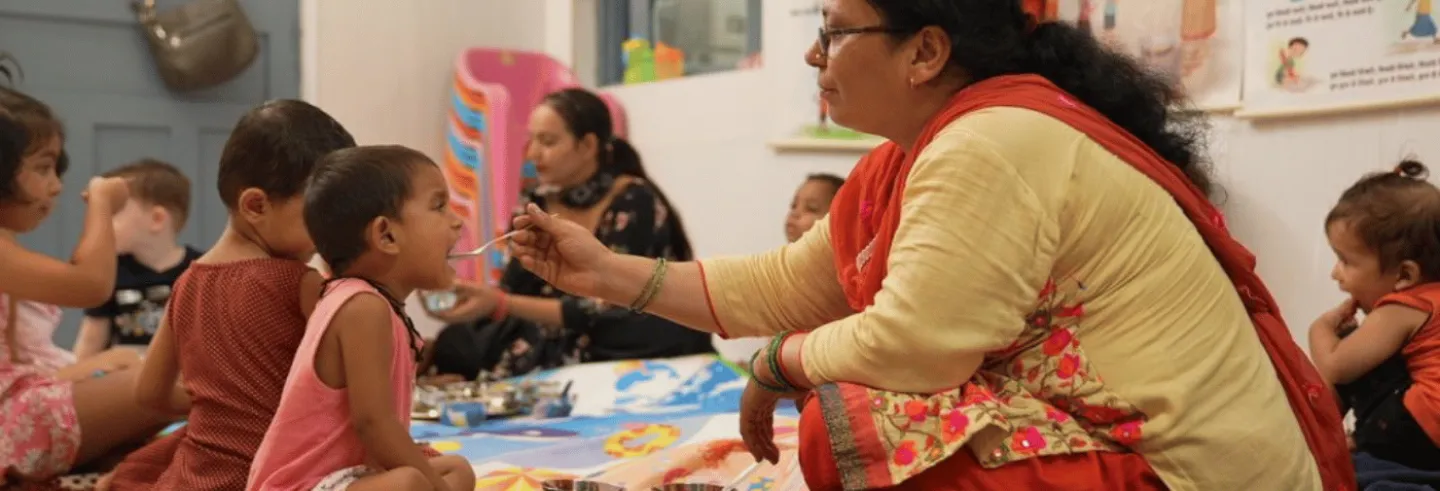This article draws attention to an important aspect related to women and child welfare in the country—the need for crèches or day-care facilities for children. The lack of alternative care arrangements for children is one of the several demand and supply-side factors that affect female labour force participation in India 1Demand-side factors include lack of gainful employment and opportunities, and supply-side factors include household and care responsibilities that limit women’s ability to take part in paid work. .
Discussions of the public care system are imperative not only for enabling women to take up paid work, but also for reflecting on the larger issues of women’s unpaid or underpaid contribution to social reproduction and the need for care support to families irrespective of their employment status. As we shall discuss, the state care-giving systems also undervalue women’s work, mostly by paying them an “honorarium”.
A wide range of research has emphasised that affordable and reliable childcare enables women to find time for paid employment, enhancing their mental health, and improving their children’s learning and nutrition (Economic Survey 2024, Barros et al. 2013). However, studies in the Indian context are scarce. Nandi et al. (2020) develop a conceptual framework (Figure 1), which shows that the lack of childcare facilities may restrict economic opportunities, and lead to psychological stress, poor nutrition, and even higher school dropout rates. All these further exemplify gender inequalities within households, communities, and in the political sphere.
Figure 1: A Conceptual Framework on the Impacts of Lack of Access to Childcare
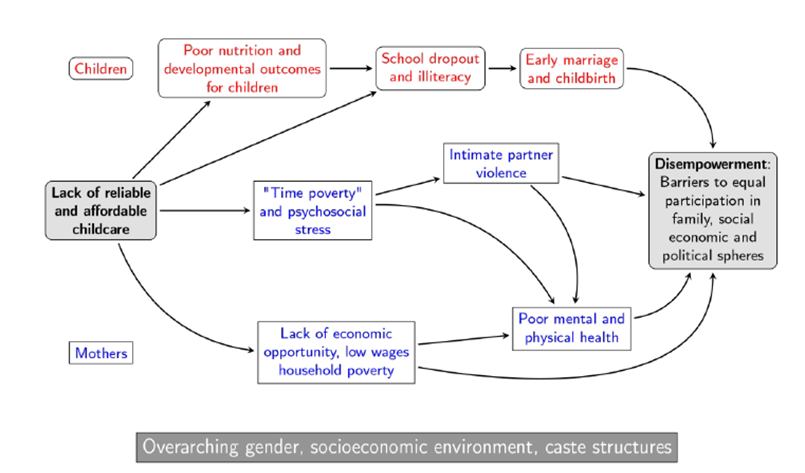
There are various laws—old and new—that mandate providing care facilities at workplaces in India. Crèches are mandated under the Factories Act 1948, The Plantation Labour Act 1951, The Mines Crèche Rules 1966, The Building and Other Construction Workers (Regulation of Employment and Conditions of Service) Act 1996, and the Mahatma Gandhi National Rural Employment Guarantee Act (MGNREGA) 2005. In addition, the Beedi and Cigar Workers Rules 1966 mention the need for crèches and the Unorganised Workers Act, 2008 press for maternity benefits in some states. The Inter-State Migrant Workmen Act 1979 recognises the need for care centres. The Maternity Benefit Act of 2017 has also been an important milestone though it mostly applies to care in the formal sector.
Garment workers complain about the absence of day-care facilities in factories that employ thousands of women workers. Even the newly passed Social Security Code 2020 does not seem to go far beyond the existing provisions.
However, there is evidence that most of these provisions are not implemented. For instance, studies have shown that the provisioning of crèches under the MGNREGA has been abysmal to non-existent in states such as Uttar Pradesh, Jharkhand, Rajasthan, and Madhya Pradesh (Khera and Nayak 2009; Sudarshan 2011; Zaidi et al. 2017). Narayan (2022) points out that one of the reasons most programmes are run better in the southern states is because crèches are provided at worksites.
Similarly, most factories are devoid of the mandated crèches. One of the organisers at the Community for Social Change and Development (CSCD), Delhi, who brings together women workers and advocates for them in the National Capital Region, pointed out that garment workers complain about the absence of day-care facilities in factories that employ thousands of women workers. Even the newly passed Social Security Code 2020, which is yet to be implemented, does not seem to go far beyond the existing provisions.
Evolving from these laws, the union government has come up with centrally sponsored schemes on crèches and day-care facilities, particularly for working women, since 2006. The evolution of these schemes raises several issues that require attention.
The funding pattern for the Rajiv Gandhi National Crèche Scheme (RGNCS), which began in 2006 under the Ministry of Women and Child Development, was 90:10, where 10% came from state governments and contributions from implementation agencies such as voluntary organisations. The responses of the ministry to various parliamentary questions reveal that the scheme was discontinued in 2016, citing “irregularities” in the management of crèches.
Subsequently, it was reconstituted as the National Crèche Scheme (NCS) with a 60:40 ratio for fund sharing between the union government and states. It had the primary objective of providing day-care facilities to children of working mothers up to the age of six. 2According to their budget descriptions, both schemes primarily provided day-care facilities for children of working women, but they also provided the same facilities to other deserving women belonging to families whose monthly income was not more than Rs. 12,000. In addition, it also aimed to provide supplementary nutrition, growth monitoring, health check-ups and immunisation, early stimulation (for children under three) and pre-school education for children (aged three to six).
Changing its nomenclature and structure, the NCS was packaged in a new bottle under the name Palna in 2022 and subsumed under the Samarthya scheme of Mission Sakthi. While most of the objectives under Palna remained similar to that of the NCS, it encouraged the integration of independent crèches with anganwadi centres, aiming to open 17,000 anganwadi cum crèches in the country. In addition, Palna extended its crèche facilities to all mothers having children between six months and six years, irrespective of their employment status. The finances for Palna were shared between the union government and the states in the ratio of 67:33.
Figure 2 shows the budgetary allocations for the crèche schemes from 2012-13 to 2024-25 as they transitioned from the Rajiv Gandhi National Crèche Scheme to the National Crèche Scheme and then to Palna.
Figure 2: Allocations and Expenditure for Govt of India Crèche Schemes, 2012-13 to 2024-25 (in Rs. crore)
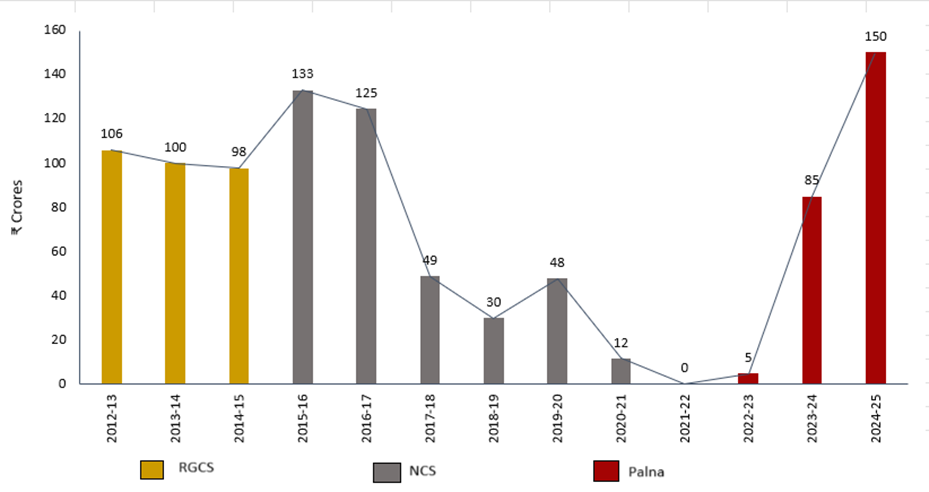
In transitioning from the Rajiv Gandhi National Crèche Scheme to the National Crèche Scheme, there was a fall in expenditure (Figure 2). While there was more money spent in early National Crèche Scheme years (2015-2017), it fell below Rs. 50 crore in the 2017–2021 period. No money was spent on crèches and day-care in 2021-22 because these facilities were closed during the pandemic. There has been an increased allocation to the scheme after its reintroduction as Palna. However, the money spent on crèche schemes in India is less than 1% of the total expenditure of the Ministry of Women and Child Development.
A glance at the number of crèches across major states in India also indicates a fall in numbers, highlighting differences in the operation and implementation of the schemes at the local level.
Several reports have shown a fall in the overall number of crèches, particularly after the introduction of Palna. In 2023, the number of crèches in India was 3,158, but the latest data has a lower number—2,163 operational crèches as on 30 June 2024. Due to the lack of data, these numbers include only government-run crèches.
A glance at the number of crèches across major states in India also indicates a fall in numbers, highlighting differences in the operation and implementation of the schemes at the local level (Figure 3). While states such as Maharashtra, Uttar Pradesh, and Chhattisgarh had more than 300 crèches during the Rajiv Gandhi National Crèche Scheme period of 2014-15, they do not now report any active crèches. 3Crèches are of two types—standalone or anganwadi cum crèches. Eight states have neither as per the latest data. For a detailed list of the number of these two types of active crèches, see Annexure II of the Lok Sabha Qn. no. 316 dated 24 July 2024. A few other states such as West Bengal and Madhya Pradesh saw an increase in the number of crèches in 2019 during the National Crèche Scheme period but they also do not have any active crèches now.
Figure 3: State-wise Number of Creches in India under RGNCS (2015), NCS(2019) and Palna (2024)
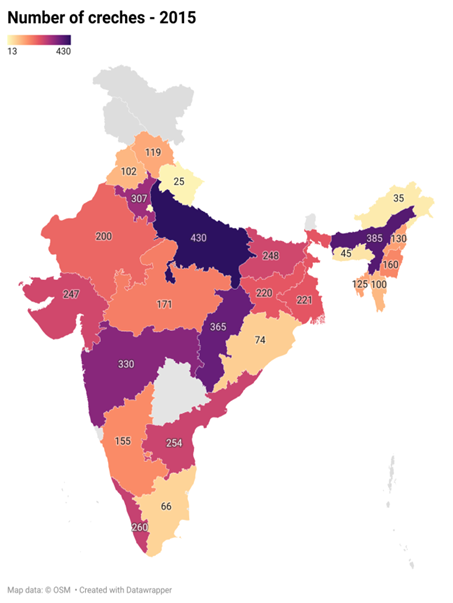
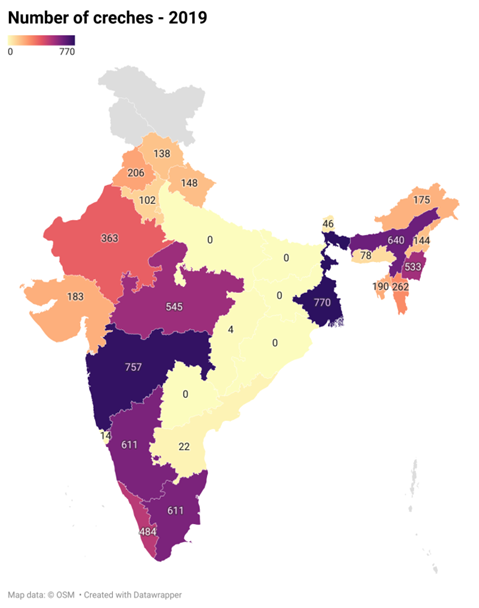
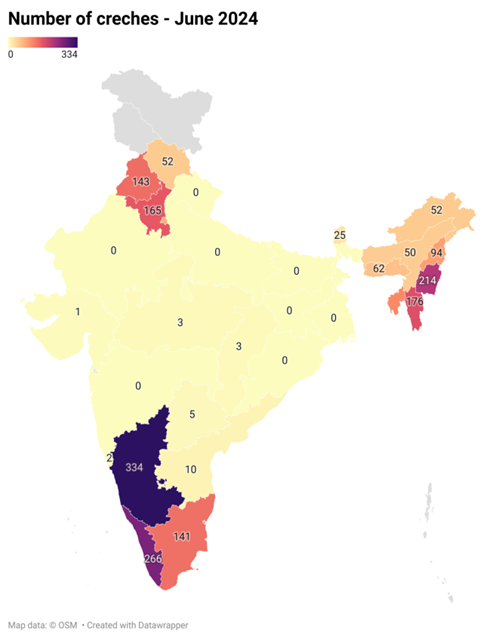
States such as Karnataka, Kerala, and Haryana, which have their own state-specific crèche schemes, mostly introduced in 2021 or later, seem to have had a consistent number of active crèches during all phases of the centrally sponsored schemes (Figure 3). However, this observation cannot be generalised nor confirmed with certainty since it needs more data to be substantiated. Details of the active state-specific schemes in these states along with their budget allocation in 2024-25 are provided in Table 1.
Table 1: Details and Budget Allocation to Active State-specific Schemes in Kerala, Karnataka, and Haryana in 2024-25
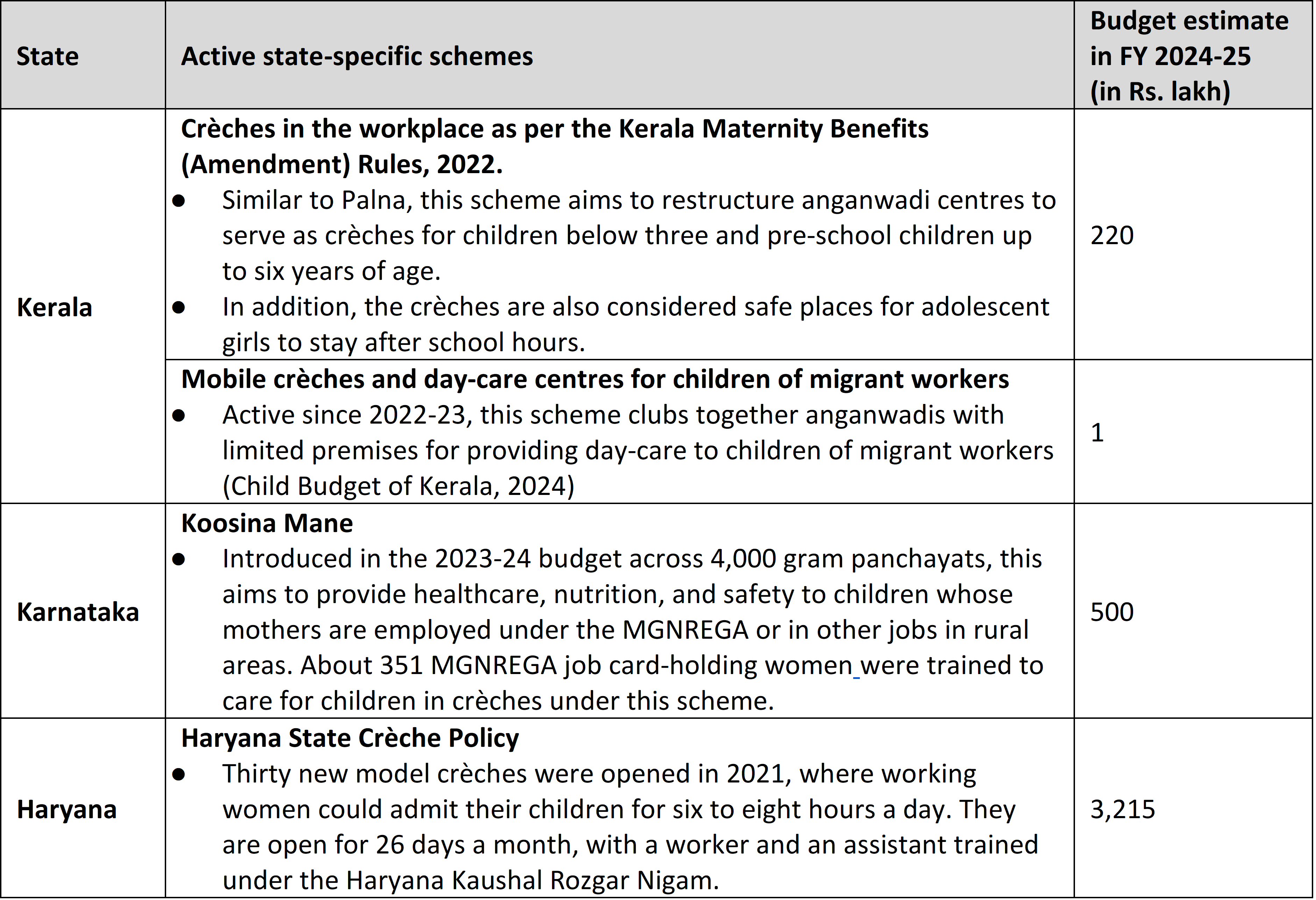
With the changing structure of the union government schemes on crèches, there are three important issues to consider. First, the declining involvement of the union government in financing Palna places an additional financial burden on state governments. In the context of debates about fiscal devolution in India (Chaturvedi, S. 2019; Economic Survey 2023-24), this has implications for states with financial constraints.
Second, the repeated transitions of the central scheme have called into question the role of civil society in care provisioning. It is argued that Palna and anganwadi cum crèches were necessitated because of irregularities in the management and functioning of non-government crèches in various parts of the country. While there may have been some irregularities and limitations, the crucial impact of voluntary or non-profit organisations such as Mobile Crèches or Self Employed Women’s Association (SEWA) in providing day-care cannot be ignored (Mishra et al. 2022, Association for Stimulating Know-How 2011).
There are concerns over the workload and payment of scheme workers (who are just given honorariums), and the procedure does not provide any guidelines on their remuneration despite increased responsibilities.
Third, several questions and concerns arise from the standard operating procedure (SoP) for Palna released in 2023. The meals provided by anganwadi cum crèches will be funded under both the Saksham Anganwadi and Poshan 2.0 and the Palna scheme. This could lead to a lack of clarity in allocating funds and providing infrastructure. Other physical infrastructure will be also shared, which could lead to economies of scale if both are on the same premises.
However, what could be more of a concern is the workload of anganwadi workers and helpers. The procedure specifies the additional work for them under Palna (along with recruiting a crèche worker and helper) and puts the onus of defining the work schedule on states. There are concerns over the workload and payment of scheme workers (who are just given honorariums), and the procedure does not provide any guidelines on their remuneration despite increased responsibilities.
According to union government guidelines, the basic monthly honorarium for an anganwadi helper and worker is Rs. 2,250 and Rs. 4,500, respectively. 4States can make decisions on the payment made to anganwadi workers and helpers and many states pay more than the basic honorarium. For instance, the Delhi government increased the monthly payment of anganwadi workers to Rs. 12,720 and Rs. 6,810 for helpers after their continuous protests. Despite long hours of work and a multitude of responsibilities, their payments remain quite poor. These payments are considered to be honoraria and not wages or salaries. This reveals the state of underpayment for care work in India. 5The minimum wage for an unskilled worker in Delhi in 2023 was Rs. 17,494, which was much more than what an anganwadi or a crèche worker was paid.
The silence of the Palna standard operating procedure on remuneration, timings, and work diversification could also lead to problems in combining crèches with anganwadis and reduced remunerations to crèche workers, as happened in Chandigarh in January 2024. Other questions arise when money from sources such as corporate social responsibility funds and smart city projects are used for day-care and crèches. There could be irregularities in allocating public funds and in sustaining it.
These issues question the viability and sustainability of the modified crèche scheme India now has, particularly its functioning across states. The guidelines and operating procedures of Palna have to be revised. More details on the operational timelines of crèches and the work conditions and remunerations of anganwadi cum crèche workers have to be in place if crèches are to function efficiently in the country.
Neeha Susan Jacob is a doctoral candidate at the Centre for Development Studies (CDS), Kerala, studying regional and spatial inequalities in urban India. Shraddha Jain is a doctoral candidate at CDS, Kerala, researching on gender relations, with a focus on women’s paid and unpaid work, and care work.

